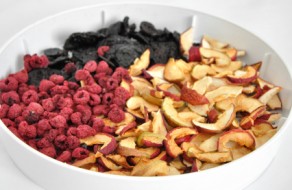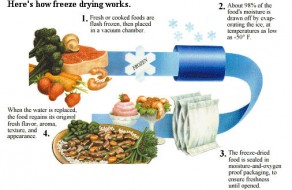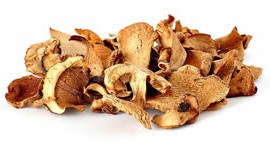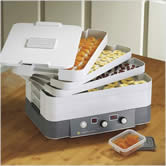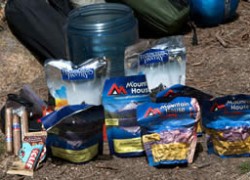Freeze-drying & Dehydration
Understand the two types of food drying processes
Many backpackers don’t fully understand the differences between freeze-dried and dehydrated foods and ingredients when planning their backpacking menus. However, there are many key differences between the two that are important to understand.
| Freeze-dried Food | Dehydrated Food | |
|---|---|---|
| Side-by-side comparison of freeze-drying and dehydration. Table from Packit Gourmet. | ||
| Weight Reduction |  |
 |
| Nutritional Content |   |
 |
| Space Savings |  |
  |
| Taste |   |
 |
| Cost |
$$$ |
$ |
| Rehydration | 5 min. in boiling/hot water; 5-10 min. in cold water |
1-2 hours in cold water; 5-20 min. in boiling water |
The Freeze-drying Process
Benefits over dehydration:
- Lightweight
- Better flavor
- Lower rehydration time
Virtually any food item and ingredient can be freeze-dried. To do this however, specialized equipment is required, making it a costly option. Few backpackers freeze-dry their own food, but buy freeze-dried brands such as Mountain House. Items are placed inside, where the water is removed by bing “flash frozen” and then placed into a vacuum chamber. Cell structure, nutrients, shape, and color are all preserved because of this rapid change, allowing the food to keep a “fresh” look and nutrition. To see the entire process, click the image on the left.
Weight Reduction
All fresh foods contain water, which is its main source of weight (fruits are more than 80 to 90% water). However, during drying about 98% of the moisture in the food substance is removed, which reduces the weight by as much as 90%, making it lighter to carry backpacking. Aside from freeze-drying’s use in backpacking and camping, the military also freeze-dries foods to make it easier for one person to carry large amounts.
Rehydration
When it is added to boiling water, freeze-dried food can reconstitute in only a few minutes. However, you may also rehydrate foods in cold water, but requires at least double the time to reach full hydration. Because of its fast rehydration time, freeze-dried foods are great and easy meal while backpacking.
Unlike dehydrated food, many freeze-dried foods can be eaten dry as crispy chips. These dry chips can be added to many different recipes to give meals a unique twist.
Backpacking Tip:
Taste
Taste, texture, and smell are, for the most part, retained in the substance after it has been freeze-dried. This is because freeze-drying uses little heat, only removing the food’s moisture and holding in the nutrients. It is believed that the flavor that freeze-dried foods have better flavor and taste than dehydrated foods.
Food Dehydration
Benefits over freeze-drying:
- More compact
- Less expensive
- Can be done at home
Weight Reduction
As said above, water is the heaviest part of food, so when it is removed, in this situation from evaporation, the weight is cut by significant amount. Around 98% of moisture is removed from the food after dehydration, making it considerably lighter when freeze-dried foods.
Space Savings
Many food items are considerably smaller after dehydration. Although dehydrated food may have a shriveled appearance, it will always plump back to life when added to boiling water for at least 5 minutes. Freeze-drying may keep the food’s original look, but it takes up substantially more room than compact dehydrated food.
Cost
Freeze-drying requires large, expensive equipment. Dehydration, on the other hand, can be done at home without the use of such equipment. Because of this, you are given more control over your backpacking meals and ingredients. This can be done through the use of a commercial home dehydrator (see on the left), a homemade dehydrator, or a convection oven. This provides backpackers with a low-cost option for compacting their food, although it can be very time consuming. Dehydrated foods and meals are also made commercially and can be purchased through many local stores and online stores such as Wilderness Dining.
Taste
After dehydration, many items receive a chewy texture, however they do not lose a considerable amount of flavor. Flavors are not completely changed, but many feel dehydrated foods are slightly less flavorful than foods that have been freeze-dried. Even still, this is the preferred drying method for some foods, including onions, peppers, tomatoes and other ingredients used in meals with long cooking times to give rich flavors.
Dried Food Shelf Stability
Because the water and oxygen have been removed from freeze-dried and dehydrated foods, it does not require refrigeration when stored and is, therefore, considered to be “shelf stable” or safe to store at room temperature for years. When bacteria and other microorganisms contaminate food, they feed on the matter and decompose it, resulting in spoiled food. Bacteria may release chemicals that cause disease, or they may just release chemicals that make food taste bad. Additionally, naturally occurring enzymes in food can react with oxygen to cause spoiling and ripening. Microorganisms need water to survive, so if you remove moisture from food, it won’t spoil. Enzymes also need water to react with food, so dehydrating food will also stop ripening. Although dried food is best as soon as possible after being packaged, foods will last several years when stored in a cool, dry location without spoiling or loosing flavor. Typically, dehydrated foods last no more than 3 years while freeze-dried foods can last 3+ years.
Additional Resources
- Packit Gourmet – Freeze-Dried & Dehydrated Explained
- Oregon Freeze Dry, Inc. – Freeze Drying: How it Works & Benefits
- Wilderness Dining – Camping Food FAQs


